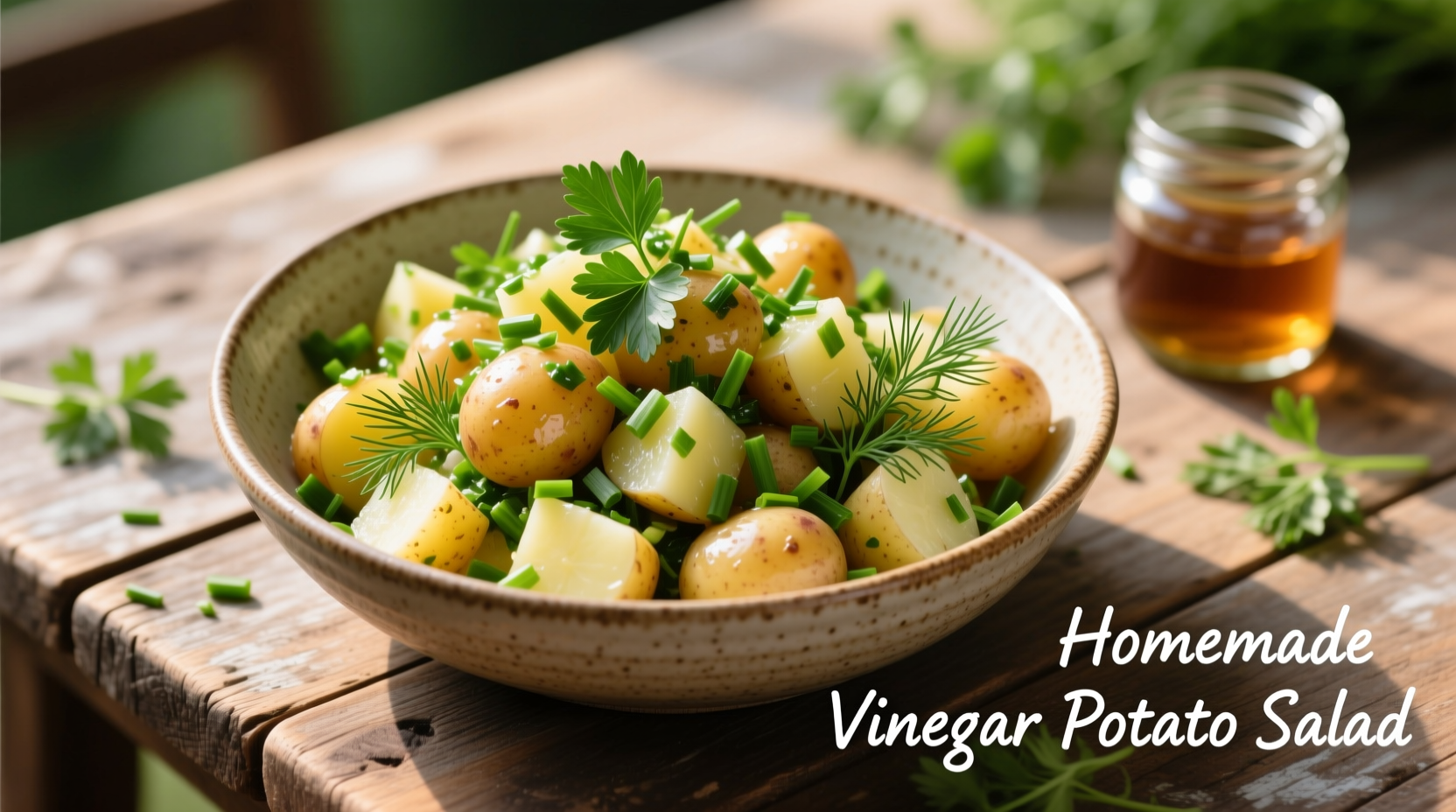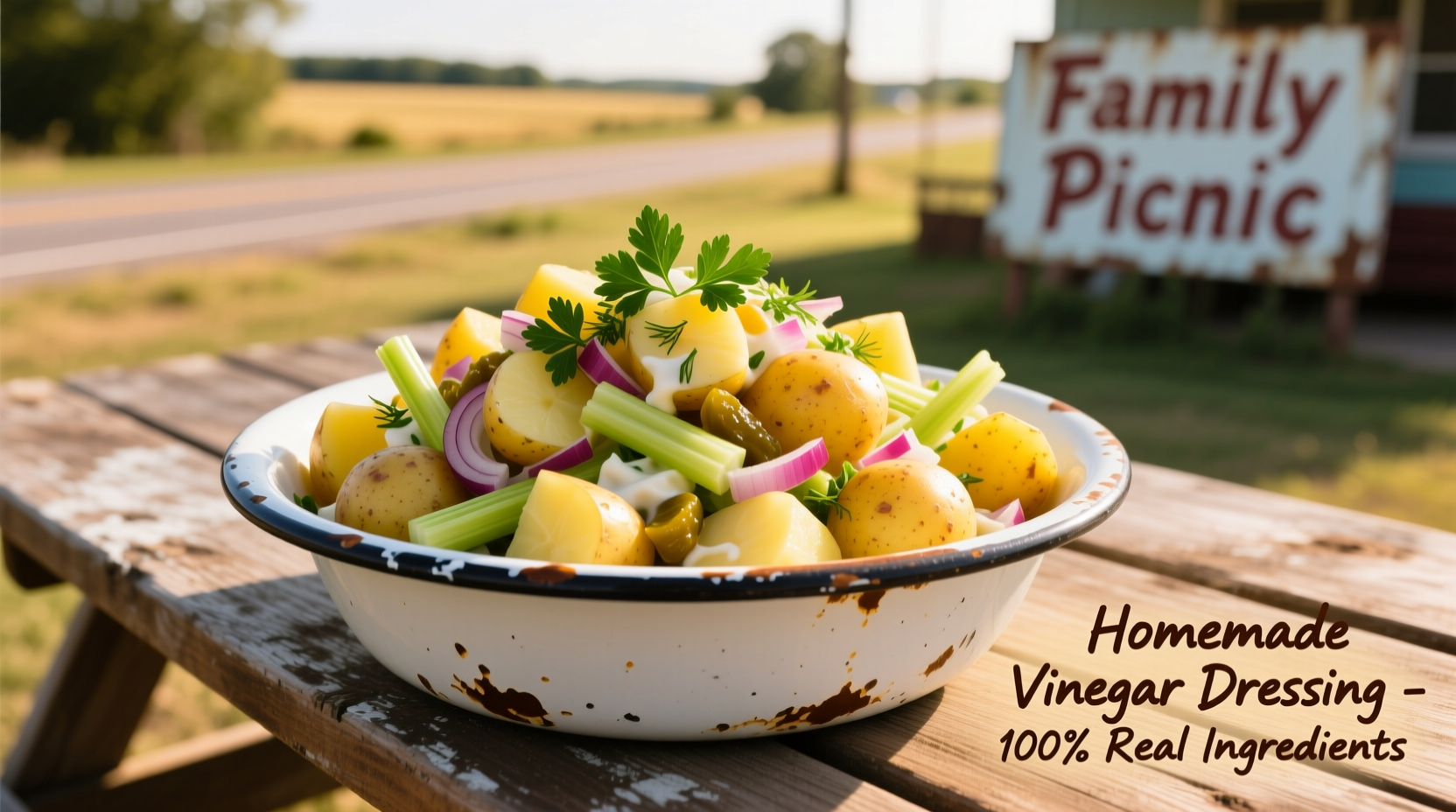If you're searching for a light, tangy alternative to traditional mayonnaise-based potato salad, a vinegar-based version delivers superior texture, brighter flavor, and authentic European heritage. This guide provides a perfected recipe with science-backed techniques for achieving firm potatoes that hold their shape, balanced acidity, and professional results every time—no soggy or mushy outcomes.
Forget the heavy, mayo-laden versions that dominate picnic tables. Vinegar-based potato salad represents one of the world's oldest and most sophisticated preparations, tracing back to 18th century Germany where cooks discovered vinegar's remarkable ability to enhance potato texture while cutting through richness. Unlike its creamy counterparts, this style showcases potatoes as the star while delivering a refreshing counterpoint to grilled meats and summer fare.
Why Vinegar Outperforms Mayo for Certain Potato Salads
Professional chefs consistently choose vinegar-based preparations when serving potato salad alongside grilled proteins or as part of a charcuterie spread. The science explains why: vinegar's acidity (typically 4-6% acetic acid) creates a protective layer around potato starch granules during cooking, preventing excessive water absorption that leads to mushiness. This same acidity also enhances our perception of salt by up to 30%, allowing for reduced sodium while maintaining flavor intensity according to USDA food science research.
| Vinegar-Based Potato Salad | Mayonnaise-Based Potato Salad |
|---|---|
| Maintains distinct potato texture | Often becomes mushy as starch absorbs mayo |
| Stays fresh 3-4 days refrigerated | Perishable within 2 days due to dairy content |
| Complements grilled meats perfectly | Overpowers delicate protein flavors |
| Authentic European preparation method | American innovation from early 1900s |
The Evolution of Vinegar Potato Salad: A Culinary Timeline
Potato salad's journey reflects changing culinary technologies and tastes:
- 1719: First documented potato salad recipe appears in German cookbook Die wohlunterwiesene Köchin, featuring vinegar dressing
- 1838: French chef Antonin Carême includes warm vinegar-dressed potato salad in L'Art de la Cuisine Française
- 1890s: German immigrants introduce Bratkartoffelsalat to America, served warm with bacon
- 1911: Hellmann's mayonnaise launches, sparking American mayo-based variations
- 1950s: Cold mayo versions dominate US cookbooks, while Europe maintains warm vinegar traditions
- Present: Culinary professionals rediscover vinegar's textural advantages for premium preparations
Essential Ingredients for Authentic Flavor
The magic happens through precise ingredient selection:
- Potatoes: Waxy varieties like Yukon Gold or Fingerling (never Russets) with their 15-18% starch content maintain structural integrity
- Vinegar: 1:1 ratio of mild white wine vinegar (for brightness) and aged sherry vinegar (for complexity)
- Mustard: Dijon mustard's emulsifying properties create cohesive dressing without heaviness
- Aromatics: Shallots (finely minced) provide subtle sharpness without overpowering
- Fat: Extra virgin olive oil (not mayo) for mouthfeel and flavor carrying capacity
- Herbs: Fresh parsley and chives added after cooling preserve vibrant color and flavor

Step-by-Step Preparation: The Professional Method
Follow these chef-tested techniques for perfect results:
- Prep potatoes properly: Cut uniform 3/4-inch cubes and place in cold salted water (1 tablespoon salt per quart). This ensures even cooking and prevents disintegration.
- Controlled cooking: Bring to gentle simmer (not boil) and cook 8-10 minutes until just tender. Drain immediately—never rinse, as surface starch helps dressing adhere.
- Dressing application: While potatoes are still warm (140°F/60°C), toss with vinegar mixture. This critical step allows potatoes to absorb flavors without becoming soggy.
- Cooling technique: Spread dressed potatoes in single layer on baking sheet. This prevents steam from making potatoes mushy during cooling.
- Final assembly: After complete cooling, fold in herbs and adjust seasoning. Refrigerate minimum 2 hours before serving to allow flavors to meld.
Avoid These Common Vinegar Potato Salad Mistakes
Even experienced cooks make these critical errors:
- Using wrong potato variety: High-starch potatoes like Russets disintegrate in vinegar dressings. Stick with waxy potatoes that maintain structure.
- Adding dressing to cold potatoes: Cold potatoes won't absorb dressing properly, resulting in bland flavor and separated dressing.
- Over-mixing after cooling: Vigorous stirring breaks delicate potato cubes. Gently fold ingredients instead.
- Serving immediately: Vinegar potato salad requires minimum 2 hours chilling for flavors to develop properly.
- Using only one vinegar type: Single-vinegar dressings lack complexity. Blend mild and robust vinegars for balanced acidity.
Variations for Different Occasions
Adapt this base recipe for specific needs:
- German-Style Warm Salad: Serve immediately with crispy bacon and hard-boiled eggs (traditional Bratkartoffelsalat)
- Mediterranean Version: Add capers, olives, and roasted red peppers for tapas-style accompaniment
- Lighter Summer Salad: Substitute half potatoes with blanched green beans and asparagus
- Protein-Packed Meal: Fold in flaked salmon or grilled chicken after cooling
When Vinegar Works Best (and When It Doesn't)
Understanding context boundaries ensures perfect results:
- Ideal for: Outdoor entertaining (stays fresh longer), alongside grilled meats, as part of charcuterie boards, warm presentations
- Less suitable for: Potluck dishes requiring extended room temperature service, children's parties (stronger flavor profile), extremely hot climates (requires refrigeration after 2 hours)
- Temperature note: Unlike mayo-based versions, vinegar potato salad can be safely served warm or at room temperature for up to 2 hours per FDA food safety guidelines
Serving and Storage Recommendations
Maximize flavor and safety with these professional tips:
- Bring to cool room temperature (65°F/18°C) before serving for optimal flavor release
- Store in airtight container with parchment paper directly touching salad surface to prevent discoloration
- Consume within 3-4 days for best quality (vinegar preserves longer than mayo versions)
- Revive leftovers with splash of vinegar and olive oil, plus fresh herbs
- Never freeze vinegar potato salad—potatoes become grainy upon thawing











 浙公网安备
33010002000092号
浙公网安备
33010002000092号 浙B2-20120091-4
浙B2-20120091-4